Jul 20 2022 40 mins 22
Why does pilgrimage have such a hold on those of us who are not religious, but merely seekers on a path that so many millions have walked before us? Author Imogen Clark talks about her Camino, the highlights and challenges, the lessons learned, and why she still yearns to set off once again.
Imogen Clark is the best-selling author of eight contemporary women’s fiction novels, and has sold over a million books. She recently walked the Camino de Santiago on a variant of the Portuguese route.
- What is pilgrimage and how is it different to just a long walk?
- How “a yearning for setting off” shapes Imogen’s fiction and how it led to her Camino
- Highlights of the route — and memorable moments
- The challenges of the journey
- The gifts of pilgrimage often emerge much later than we expect
- Practicalities of the Camino Portuguese coastal route
- Recommended books
You can find Imogen at www.ImogenClark.com and on Twitter @imogenclark and Instagram @imogenclarkauthor
My book, Pilgrimage, Lessons Learned from Solo Walking Three Ancient Ways, which features this Camino route, is out now.
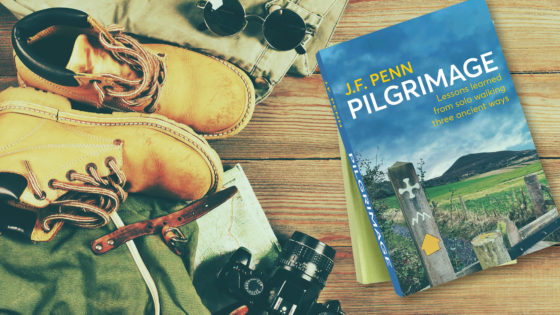
Transcript of the interview
Jo Frances Penn: Imogen Clark is the best-selling author of eight contemporary women’s fiction novels, and has sold over a million books. She recently walked the Camino de Santiago on a variant of the Portuguese route. Welcome to the show.
Imogen Clark: It’s lovely to be here.
Jo Frances Penn: Fantastic. So, let’s start with a question of definition, really.
What is pilgrimage to you, and how is it different to just a long walk?
Imogen Clark: I think it is a very, very personal thing. I have no religious faith. I was brought up within the Church of England, and I spent a lot of time in the Church of England because I sing in a choir, but I don’t have any faith. But I am always seeking I think, and I’m always seeking spirituality, and by my nature, I’m very, very curious.
So I think the pilgrimage for me was partly because I was curious about exactly what would happen to me if I was on a pilgrimage. But also, I think the idea of walking to a specific place, with a common purpose, with lots and lots of other people, because the Camino is very busy. There are a lot of people all walking in exactly the same direction, all doing exactly the same thing as you. I found that very, very comforting that there were so many people all seeking the same thing as me.
And I also found that it’s so uncomplicated when you’re walking…when you’re traveling generally, usually trying to fit things in, and trying to see different sites, and you’ve got a list and that kind of thing, and similarly, if you’re doing a walk as well.
But when I was doing the pilgrimage that wasn’t the idea. Obviously, we passed things, and we saw beautiful things, but that wasn’t the focus of what we were doing. They were the things that we saw as we walked to Santiago. And that’s a different emphasis and I’ve never really done a walk where it was just the walk that was the important thing.
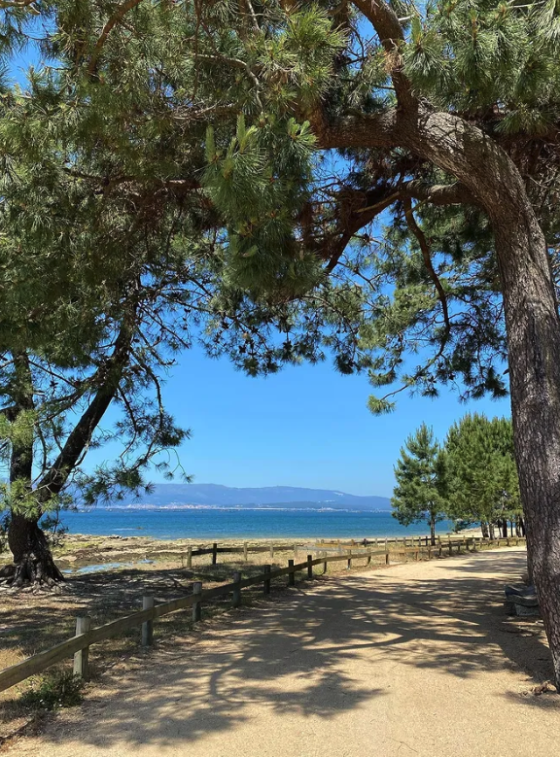
Jo Frances Penn: Oh, you brought up loads of things there. I just want to come back on why now? You mentioned that you don’t have any faith but you are a seeker and you are curious.
Did something happen in your life that made you want to walk this Camino? Because of course, there are many different pilgrimages you could have walked.
Imogen Clark: I think I’ve always been aware of the Camino, so it was always something that I was interested in doing. But the thing that happened that made me really want to do it was that my children all left home. So they all went off to work and college, and what have you, and suddenly, I had the time really to focus and devote on things that I wanted to do as opposed to constantly doing the things that other people wanted me to do.
And so when I started to think about what I would like to do in that time when I wasn’t rushing and trying to sort everything out for everybody else, this was an obvious thing. So even though it’d been in the back of my mind for probably 15, 20 years, it’s only now when I was able to go away without worrying about what everyone else was doing.
And I think part of it being a pilgrimage is that you do have to focus on it. And so if I’d gone and the children were still at home, I’d be constantly feeling like I had to ring in to make sure everyone had got what they needed for school and all those kinds of things. Whereas this time, because they were all busy doing their own thing, I could entirely focus selfishly almost, on me, and the pilgrimage, and what it was that I was trying to achieve.
Jo Frances Penn: I think that’s great. And it’s interesting though because I don’t have children, I am happily child-free, but I have also thought about doing this for, like, 20 years, probably even more than 20 years, and I then vowed when I was lying ill with COVID that if I died, it would be the one thing that really annoyed me that I hadn’t actually achieved. It was on the list of, ‘I wish I had done this in my lifetime.’
Do you remember how you first heard of it? Because I feel, like, Church of England, for example, doesn’t have such a pilgrimage tradition as the Catholic faith. Do you remember where it came from?
Imogen Clark: I can’t remember specifically where it came from, I think I just…it feels like I just always knew it was a thing and it was there.
And I think because the part of the Church of England I was involved in was very high church. As a girl I did a lot of singing in cathedrals, and so I was very used to the very high Anglican faith. And it’s less odd within that part of the Church of England in the sort of pilgrimages, and retreats and those kinds of things fit more neatly I think, into that part of the church, so I was just always aware.
I suspect possibly, I saw something about it…I used to sing in Canterbury Cathedral every summer when I was a girl when the boy choristers were on holiday, and they used to invite choirs in to come and sing Evensong and the other services. And I suspect there was something, some display or something within the cathedral that I saw back then when I was, however old in my teens that made me think, ‘Oh, that’s interesting.’ Fancy walking all the way across Spain, can you imagine that kind of thing? I mean, it just stuck with me really.
And I think I have a real yearning for just setting off.
I think it’s very interesting that some of the books I write, and a lot of the books I read are people just setting off and doing something. And I think when you just…obviously, there needs to be a plan, but when you just want to just start, and you just want to go from A to B, without it being a huge holiday kind of thing, those things have always really, really interested me. So I suspect just the mere word pilgrimage made me think, ‘Oh yes, let’s see what that’s about, and let’s just set off.’
Jo Frances Penn: It’s interesting also you used the word ‘selfish’ about yourself kind of doing something for yourself, but I almost feel like pilgrimage, it’s not a holiday. Like, it is obviously travel, you’re seeing things, you’re probably eating some decent food at some point, although it’s never about the food, and you’re physically tired and there are lots of challenges.
Did you get over this feeling of it being maybe selfish time. Did you embrace it for what it was?
Imogen Clark: Yes. I really did because I think, what’s the point of going if you feel guilty all the time?
And I did think, ‘This is the whole point of doing this walk,’ apart from curiosity, which is the motivation for loads of the things that I do. But was really, to get some time where I could just breathe really, and think.
And normally, I’m very busy, and I’ve got a butterfly kind of brain, and I’m always doing at least three things at once, and I listen to loads of books, so I’m very rarely actually just in my own headspace.
And before I set off I said, ‘Goodness me, you’re going to do all that walking. You’re not going to listen to a single thing. How on earth is that going to work?’ But actually, it was really, really lovely to just take that time and be in my head.
I mean, I was with my husband as well, I wasn’t on my own. But be in my head and not be frightened of being in my head because sometimes I think it’s best if we don’t go there, spend too much time contemplating things, and just crack on with the next thing that needs to be done.
But being able to have that almost selfish step, and just take that step back, and literally just think about the things that were important to me in the moment, that was quite a luxury really and not something that I generally do.
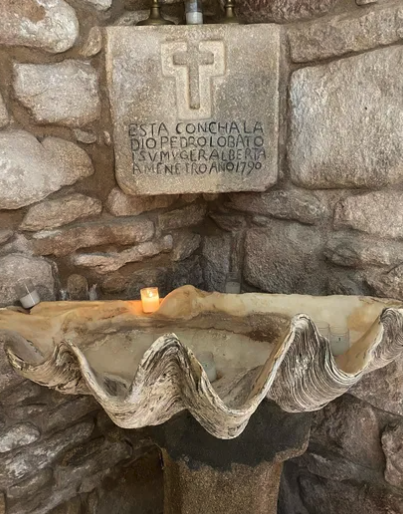
Jo Frances Penn: You mentioned that you went with your husband. Were you with a bigger group as well?
Imogen Clark: We weren’t but you kind of are because there are so many people.
John and I went together as a couple, but immediately we got off the plane and there was a group of ladies who were catching our bus, and John said, ‘I bet they’re doing it as well,’ and I went and spoke to them, and lo and behold. And then we kept seeing them at various places, and we bumped in…there were lots of people who you see in their custom that they’ll have a day off, and then they’ll restart, and you’ll meet up with them further down the track.
And it’s because everybody is going as I said, in the same direction, at the same time. It is like walking in a group and you bump into people who you maybe only see at lunchtime, but then you then see them in the evening, not to speak to particularly, but they’re sitting outside a bar or whatever. So there’s lots and lots of opportunity to speak to strangers as well as being with the person that you’re actually with, so it was…even though that we were only two…and everybody felt like we were only two because there were just so many people.
Jo Frances Penn: Well, that’s really interesting because when I did the…in fact, both the Pilgrims’ Way and the Cuthbert’s Way, I had whole days on my own, walking on the path.
And I have heard this about the Camino and I’m doing a slightly different Portuguese route. And for the listeners, as we record this, I have not yet walked my Camino, and I will also be doing the Portuguese route.
But this is something that in a way slightly worries me because I like walking alone, and yet I feel that that is respected, but do you have to be rude to people? You know, I’m English at the end of the day, so we have subtext. And often people of different cultures don’t appreciate body language or subtext that says I want to be on my own.
Were there ways of having solitude or being alone, even with so many people on the way?
Imogen Clark: Yes. I think so. And I think you sort of get into the habit of saying, ‘Buen Camino,’ as you walk past everybody. I walk quite fast, I’d say we walked past a lot of people that we overtook everybody.
But you always speak to them as you’re going past, but there’s no necessity for it to be more than that. And so many people were walking on their own. It was really…I think more people were walking on their own than were walking in groups. So it’s definitely something that is respected.
And there were parts we took a different route, a variant in Portugal. And that bit was really, really quiet because it was off the main Camino. And the Portuguese route is more quiet than the Spanish route, so there were places where there were not other people.
And where we were up on the hills, John and I, we didn’t see anybody for hours, and hours, and hours. But in other places, it did feel a bit like a motorway. And there were just…took me by surprise…I hadn’t realized it was quite such an industry.
You have to collect your stamps in your passport as you’re going along to prove that you walked the requisite distance. And there’re so many cafes with the shell, which is the sign of the Camino outside, and bars, and churches, and places where you can go to get your passport stamped. And I hadn’t really realized that there was a whole industry around the Camino in that part of Spain, but everything is set up around this pilgrimage, and all these people constantly coming through. I think it’s between 500 and 1000 people finish every day.
It’s so many walkers, so many pilgrims. That surprised me. I wasn’t quite prepared for that quantity of people.
Jo Frances Penn: And so what time of year did you walk? Because that might give people a bit of a clue as well.
Imogen Clark: We did it in May, and the reason why that part of the world is so green is because it’s a bit damp. So we had I think more wet days than dry days, but it wasn’t cold and it was fine. I was expecting it to be wet. And apparently, it is busy most of the time, it gets very busy in the summer when it’s not wet, but then it would be extremely hot.
And the route that we did, it was quite hilly some of it, and some of the days are quite long. So I think if you were doing it in the height of summer unless you are used to walking in those kind of temperatures, I think it would be quite challenging.
Jo Frances Penn: I’m doing it in September, which I guess will be similar to May.
Imogen Clark: It should be drier, I think.
Jo Frances Penn: Yeah. Hopefully a little bit.
Tell us about some of the highlights of the route for you. What were the places that you were like, ‘Yes, that was brilliant,’ or just lovely, or beautiful, or whatever you remember as a highlight?
Imogen Clark: There’s so many beautiful places and so many tiny, tiny little churches and chapels that you kind of would not have noticed if you hadn’t been going slowly, and thinking about, and looking out for shells, and all those kinds of things.
And inside some of these tiny little chapels, they got the most beautiful artwork, and fabulous frescos, and things and you just think, ‘Well, where on earth did the money come to provide for this tiny little chapel, but there it is.
And crosses everywhere all the way along, very, very ancient stone crosses that were just gorgeous.
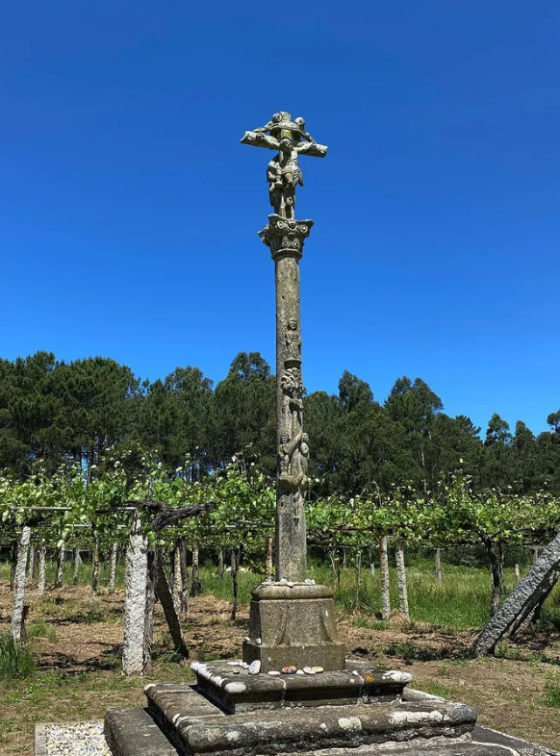
But places-wise…so we passed through this fishing village called Combarro, which was absolutely beautiful, and picturesque, and very much like sort of a Cornish fishing village.
And one of the things that they have in that part of the world are these huge stone grain stores that they built, I think really to keep the grain away from rodents, and bats, and what have you. But they’re everywhere, and they’re absolutely huge, and beautiful, and all the way along the coastal path were all these stone grain stores. And I’ve never seen them before, and so they were so interesting and so lovely.
And I think we saw various churches within the towns that we passed. Obviously, the cathedral in Santiago itself is breathtakingly beautiful. I’ve been in a lot of cathedrals but I have never seen anything like the shrine to St. James. It makes you want to cry, it’s so beautiful. And so that was so lovely when we reached that point.
We passed through a little church where a local fisherman had pulled up a huge seashell, and he’d given it to the church, and the church was using it for the holy water by the door. And those little things, those tiny, tiny little churches with these little stories attached to them, those were the kinds of things that really stayed with me as I was walking.
We went to one chapel where there were some people inside who were evangelists, and they wanted to sing and celebrate our walk. And then when they’d done that, they said, ‘Oh, that chap on the bench outside,’ he said, ‘He’s 97, and he rebuilt this chapel. Him and his son rebuilt it because it had fallen down.’ And so they rebuilt it, and now he just sits on the bench outside and watches all the pilgrims come past. And it was just such a lovely, lovely story, such a human side to the walk. And it’s those kinds of things that stayed with me really, the human bits.
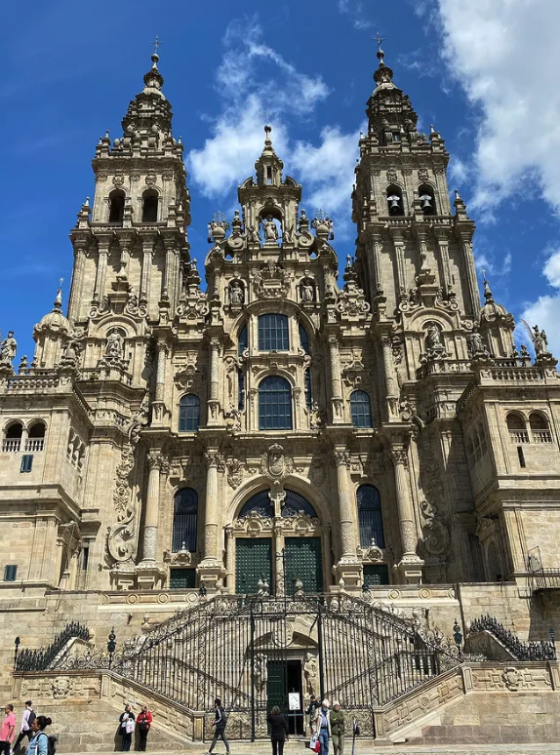
Jo Frances Penn: And you’ve mentioned hills and I guess, some of the landscape.
This was the coastal route, right? Were you by the sea at any point?
Imogen Clark: Yes. There were bits by the sea. I think it is very varied. There were lots and lots of bits by water, but rivers, there was one particular part that the path of stone and water, which was a path that ran beside this…more of a stream than a river really, but all the way along there were mills where they milled all the grain and everything for the bread.
And just on this tiny little path, there was so much stone because they needed the drops of the water to make the mills work. And then these beautiful, tiny, tiny little mills, every 300 or 400 yards. That was just so pretty. The dappled light, absolutely lovely.
And then one day we were walking up a hill, it was quite, quite steep…and I’m from Yorkshire I can do hills, but it was quite steep, but it was a eucalyptus plantation so you can imagine, the smell was fabulous. And the path had been made from…I think there must have been crushed oyster shells in it because it had the tiny little mother of pearly bits that you get inside oyster shells on the floor. And those were all reflecting light and making the floor shimmer beneath you, and this smell, and the heat, and walking up the hill.
And then we get to the top and just, the trees cut away, and we got opened up this beautiful vista, and then we were looking down over this bay of the coast obviously. And that was a breathtaking moment as well because it’d been a trudge to get up this hill and it was hot. And then we got to the top and suddenly, we were rewarded with this spectacular view. And it was full of moments like that, where it was hard and then suddenly something beautiful would happen and you think, ‘Okay,’ so yeah, it was worth working 10 miles up that hill to get to this view, things like that really I think, all the way along.
Jo Frances Penn: I have a really practical question, and I do think this is important. So, some people wear heavy walking boots. So for example, walking in Yorkshire in October, November, you’re going to wear some chunky walking boots, right? But I’ve seen people walking these Camino paths in just more like walking shoes, like, light walking shoes or even sandals.
What kind of footwear do you think you needed for that route?
Imogen Clark: Well, I wear track shoes that they run in. So when you see these people who do…well, the Ultras, I know you’ve done Ultras as well. And the people who run the Ultras, who wear these very, very light with very thick soles, running shoes. And so that’s what I wear because they’re so light and they’re so comfortable.
And I think you don’t need big boots because obviously, it’s Spain and it’s hot. But also at no point was the path particularly muddy, or any of the things that I would need boots for. And people were walking in all kinds of things. I saw one girl, she inspired me to write a character actually because she was so lovely. She’d got pink hair, and she just had a tote bag, and she’d a scarf hanging around her hips, and she was walking in flip-flops.
And I thought, ‘Look at her,’ she’s one of those devil-may-care kind of, ‘I’ll just turn up and it’ll be fine,’ kind of people. And you could see everything about her just from the way that she was dressed. And she stood out a mile because she was so…she looked so different to everybody else who…there were a lot of people with khaki and creases from the packets still in them. There were a lot of people who clearly didn’t do a lot of walking, but just had bought new things specifically to do the Camino, so she was like a breath of fresh air with the flip-flops. I wouldn’t recommend doing the flip-flops —
Jo Frances Penn: I was going to say!
Imogen Clark: You need some decent boots, yeah. I mean, a couple of the days were sort of between 15 and 20 miles, 3 or 4 of the days were between 15 and 20 miles. And at the end of the day, it’s not to be taken lightly because even if you do a lot of walking, walking consecutive days with those kinds of mileage, it can be hard on the hips, and the shoulders, and everything. So yes, you do need to make sure you’ve got a kit that suits what it is that you’re trying to do.
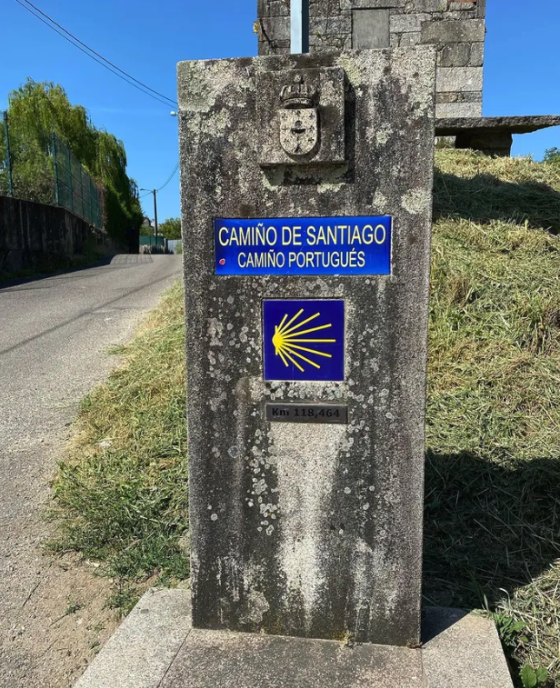
Jo Frances Penn: That is good. And then I guess another practical question as well, in terms of finding water, and food, and toilets, like you said, it’s an industry.
Was it always easy to find places for those water and food?
Imogen Clark: Not always. It’s the great outdoors so there aren’t always toilets, but there are little bars all the way along the route. But sometimes the bars were quite spaced out and often you didn’t get to the places where the bars were at a time that was a meal time.
And also I get up very early in the morning, and I go to bed quite early, and I’m very morning-focused. And my body clock was completely at odds with the Spanish body clock. So, the Spanish time, they start much later, and we couldn’t even get breakfast before half past eight, which is like, ‘Oh my goodness me.’
Now, I’m normally up with a lark, and then things close in the afternoon. So we learned to be quite creative making sure that we had got enough to drink, and eat, and everything for that gap between sort of 2 and 7 when everything was shut. So you do have to be quite well organized I think, and not just assume that you’ll stumble across the most perfect tapas bar at exactly the right moment because it doesn’t always happen.
Jo Frances Penn: Yeah. I actually thought about moving to Spain in the ’90s and it was the same reason. I was like, ‘I cannot live in this country where they eat dinner so late,’ and I’m like you, I get up early and I go to bed early and it just didn’t suit me.
Imogen Clark: Yes. And my husband said, ‘Imogen, you can’t expect them to change their entire way of life because you are here.’ But obviously yeah, but we were there 10 days, we got used to it, I got used to it by the end. But yes, it’s quite a big switch of your body clock, I think, to be able to eat very late and yeah, get to bed late.
Jo Frances Penn: As we mentioned, pilgrimages are not meant to be easy. And you mentioned there some of the long days, some pain in your hips, and your shoulders.
What were some of your greatest challenges along the way?
Imogen Clark: As I mentioned before, I walk very quickly and my husband does not. And so that was quite a challenge because even though that sounds a bit trite, actually I really had to focus on slowing down so that I wasn’t just doing this for myself.
We were there as a pair and it was important that we were together and my temptation is to go much faster than him. And he would say, ‘It’s not a race,’ and I would say, ‘Well, I’m not racing. I’m just walking at my normal speed.’ We had this ongoing debate that my normal speed was not normal and his normal speed was closer to normal and I needed to slow down, so that was quite a challenge for me.
Also, I think you have to put aside your wish to stop and look at absolutely everything because the focus is on the actual pilgrimage. And I’m like you, if there’s a little path that goes off somewhere else, I’m likely to be on it just to see where it goes and all those kinds of things.
And I had to pull back from doing those kinds of things because I had to remember that I was supposed to be on the pilgrimage, and I was following this path for a reason, and there was a reason why I had to go this way and not any other way, so that was something else that I had to do.
As far as it being a physical challenge, I think if we’d gone further…we only did the last 120 kilometers, if we’d gone further obviously, that would’ve been more difficult and because we’re middle-aged people, we were staying in nice hotels and not backpacking.
And so, we didn’t make it that difficult for ourselves because there was always a hotel at the end, and we weren’t carrying our kit. So I think there were ways in which it would be much harder, I think, than the way that I actually did it.
But it is getting up and doing the same thing every day. That requires a degree of mental fortitude I think. And sometimes when it is very hot, or it is very wet, or all those kind of things, you’re gonna say, ‘This is supposed to be fun,’ well, yes, it is fun, you’re enjoying it, but, you know, it’s hard and you have to just keep pressing on, you’ve got to get to a particular point because that’s where you’re resting that night. And so yes, it’s not easy. It’s not for the faint-hearted.
Jo Frances Penn: I think that it’s Type 2 fun. It’s not fun at the time, but it might be fun if you look back at it later.
But also, like you mentioned there, you stayed in hotels and you didn’t carry your bags, but to me, the whole point, or one of the points of the Camino is that it’s your Camino.
And so there is absolutely no problem staying in hotels or having your bags ported from one place to the next. It’s your Camino, whatever you want it to be, and you choose your challenge, and I think that’s the important thing.
And I don’t think there should be any judgment for how people do it, I mean, like you were celebrating that girl who was in flip-flops, you know, my immediate thought was, ‘There’s no way she made it to Santiago,’ you know what I mean? But it’s, like, her Camino, who knows her Camino might’ve only been a couple of days. And so I think that’s really important too.
So you must’ve met people who had just completely different attitudes, I mean, she was obviously one of them but, I mean, you do pick characters for your books as you said.
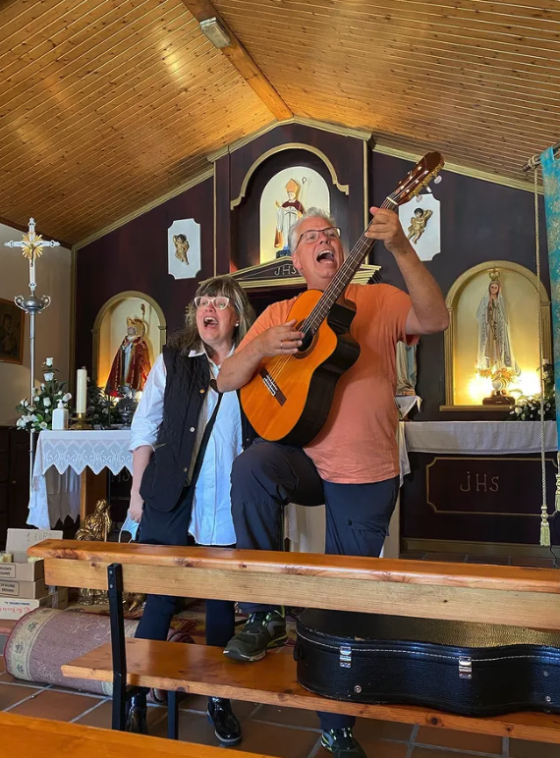
Were there any other interesting characters?
Imogen Clark: Yes. We met one chap, and he had this conversation as you’re going along with people that you meet, ‘What’s your motivation? Why are you here?’ And he said that he was there because he had triplet boys and he was the main carer. His wife went out to work and he had worked a lot from home.
And he said, ‘I’m here because I need them to know that they can live, they can do it without me.’ And I thought that was really interesting. The thing that was motivating him to be able to do this walk was just to show that he wasn’t as indispensable as his family thought.
So, in a kind of a roundabout kind of way, what he was getting from his Camino was all about showing them that he was able to have the freedom and their lives wouldn’t collapse if he wasn’t there. And I thought that was interesting that that was the way that he was approaching it.
Jo Frances Penn: Well, that actually means a lot, you saying that, because weirdly, that is one of the reasons I do this because, we’re both authors, and I run my own business and have done for nearly 15 years, and I rarely ever take a day off, like, a whole day off in terms of not making sure things are ticking over on the business, like emails or whatever I’m doing.
And when I do these pilgrimages, I remember that I am not indispensable. And this is such an amazing lesson that I have to keep learning.
And what I’m hoping to learn again on the Camino is that life carries on. Like, you don’t need to check social media; you don’t need to do email. No one’s going to die if an author doesn’t email a reader back, right?
Imogen Clark: Absolutely. But I think we lose sight of that, don’t we?
Because we’re so busy, and everything is also very important, and it’s very easy to lose sight of what the important things are. And it’s like I said in the very beginning that, it’s a simple thing, so simple is walking. It’s putting one foot in front of another until you get to the place you need to be.
And it’s that simplicity I think, that is the magic of doing something like this because you just…there’s no point getting caught up in all that other stuff because like you said, it doesn’t really matter. There’s very little that won’t wait until you get back. And once you get your head around that that’s what you’re doing, it’s liberating, it really is to just not look at your phone every five seconds. It’s fab, I loved it. I really enjoyed that aspect of it.
Jo Frances Penn: Exactly.
So, I found that the gifts of pilgrimage didn’t really emerge at the time, as in I was almost frustrated that I wasn’t having this moment of spiritual awakening in somehow, but later on things emerged.
It’s been a few months now for you. What are some of the things that have emerged since you’ve been back?
Imogen Clark: I think that’s absolutely true.
I also had this idea that there would be lightning bolts and all amazing thoughts, I’d have all these moments as I was walking along, none of which happened. I did have a couple of moments where I got quite emotional when we saw things that were so beautiful, but really…and I also had this idea that we would walk into Santiago, and it would be glorious, and shining…there would be a big gang, and it would all, you know, just there’d be..not necessarily with these people, but just in all moving together.
And as it turned out, it was a wet, cold, gray day. And the Portuguese route comes in through the city, it’s not a very nice part of the city, and all those visions I had of my beautiful arriving at the end of my pilgrimage were all completely rubbish and none of that happened.
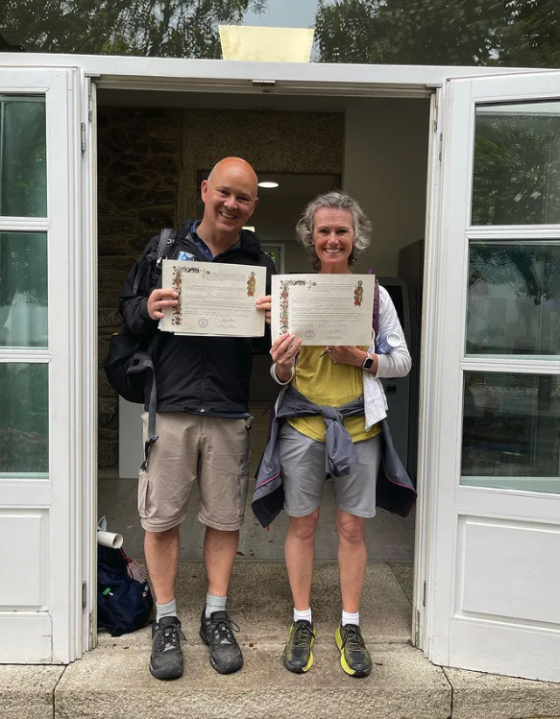
So it did feel like a little…not an anti-climax because we had walked all that long way, but it wasn’t as I had envisaged it. So I completely agree that it isn’t quite what you think when you’re there.
But coming away, I’ve had a meditation practice for a number of years now, and I find that that helps me to focus and what have you, but since I’ve done the pilgrimage, I feel calmer, it does sound a bit silly, but I do feel like my busy life…the busy life that we have as authors, and just people, everybody’s busy, aren’t they? I’ve been able to focus more on the things that are actually important instead of getting caught up in the, ‘Oh, that email came in five seconds ago, and I need to respond to it otherwise they’ll think I’m not interested or whatever.’
I’ve let all those things go I think, and I’m sure they will build up again because of course, these things always do, don’t they? But certainly, since I got back, those are the things that I found easier to just sort of go, ‘Do you know what? That actually doesn’t matter, let’s reevaluate our priorities here.’
The important thing about this is to breathe, or to take time out and go and look at that view, or to not necessarily sit at your desk answering all these emails so you can tick them all off, and get to the end of the day with that smug, satisfied, ‘I’ve done all my tick list,’ because those things whilst they are of course important, they’re not always important, and they’re not always the priority.
And being able to take time out, and think about wider issues as I did when I was walking along, that’s the kind of thing that I think I’ve taken away. And also, I think I’ve also… I have a hunger for it now. I’ve very much enjoyed that sense of common purpose and the simplicity of it all.
And so I imagine that I will do another, I haven’t chosen which yet but I imagine that that will be something else that I do.
It’s very difficult to put into words exactly what it gives you but it most definitely does give you something that you didn’t have before. And as a seeker and as a curious person, I will be seeking that again, I think.
Jo Frances Penn: Indeed.
Well, you mentioned though that you had some emotional moments rather than lightning bolts, and sometimes these sort of quiet realizations or glimpses of…I always say something beyond the veil, or the veil is thin in this place, where even if you don’t believe in a Christian God or any kind of religious God, there is still something there.
Did you find those quiet moments of spirituality along the way?
Imogen Clark: Yes. I think so. And I wasn’t really expecting that, it took me by surprise because I was expecting for it to be a spiritual experience, but I wasn’t expecting it to reduce me to tears, and so I was quite surprised.
And there were two or three places, the little chapel I mentioned where the lovely American couple were playing the guitars and singing to all the pilgrims, they were so lovely and so welcoming. And there’s something…I think something very evocative about singing, I think it hits all kinds of emotional notes for me.
I felt like they were there, and they were making time for me because I was a pilgrim, and they didn’t know me from Adam, and they never met me, and I would be gone, and they would be gone to the next pilgrim who came through the door. But in that very moment, I felt like they were wanting to impart something specifically to me. And that was quite moving really I think.
Then obviously, there’re lots of very beautiful, natural moments, you know, as I’ve described and those are awe-inspiring often. And particularly, when you’re focused on taking the time to actually look, because a lot of the time…you know, I live in Yorkshire Dales, it’s absolutely beautiful, but some days I don’t even look because I’m busy.
So you need to be able to be somewhere and notice the smell of eucalyptus trees or notice that the floor is made up of little bits of oyster shell or whatever. Those can be very special moments.
And I think when we got to Santiago, we were very fortunate because it happened to be one of the days when they were swinging the Botafumeiro, which is the giant incense thing that they have there.
And it takes eight people to swing it, it’s so huge. It’s like a wrecking ball, it’s amazing to see. And the cathedral was packed, partly because they have a service for the pilgrims every day. But that was even more packed because the Botafumeiro was going to be swung that day as well. And that common purpose again used to be in a building with all these people who had all just done exactly the same thing as I had done.
That was a moving moment as well because that’s what it is to be human, and I think we sometimes forget. And particularly, post-COVID, and all that kind of stuff, we’re all very cautious of each other. And we’re all dancing around, and not standing too close, and being concerned if somebody looks as if they might cough, and all those kinds of things. And suddenly, there were all these people, all in one place, and that wasn’t what they were interested in at all, and they were really interested in this beautiful building that we were in. So that was very moving as well, possibly as I said because it’s been so long since we’ve had moments like that, but it was beautiful.
Jo Frances Penn: It’s funny that Botafumeiro, I used that in Stone of Fire as a plot device.
Imogen Clark: Oh, it’s fantastic. Have you seen it?
Jo Frances Penn: I haven’t. No, I haven’t. I’ve only on YouTube videos, but I haven’t seen it. So I’m going to put it out there to the universe that it’s being swung when I get there because I’d love to see it.
Imogen Clark: Absolutely. That’s exactly what I did. And lo and behold, it worked. So yeah, if you get to see it, it’s spectacular, it’s astounding. I’ve never seen anything quite like it, so when you are there, go see it.
Jo Frances Penn: Brilliant. Well, we’re almost out of time, but this is the ‘Books and Travel’ podcast.

What are some of your favorite books about pilgrimage, or routes, or travel in general?
Imogen Clark: Well, as I mentioned, I quite like books where people just set off. There’s something very interesting about just setting off my own first book. It was inspired by me wanting to run away because having four children is sometimes quite challenging, and I just wanted to just, ‘I’ll just go and get on a plane and fly somewhere else,’ so it’s that kind of thing with the books that I’ve chosen.
The first one is ‘Wild’ by Cheryl Strayed. She walked 1100 miles along the Pacific Crest Trail, and they made a film about it.
But the thing that I really enjoyed about that book is she was so woefully ill-prepared when she set off, her boots didn’t even fit. She had absolutely no idea. She had a bag that she could barely lift. She had just no idea where she was going. She hadn’t got the appropriate kit or anything, and yet she just set off, and more astoundingly, she finished.
I think the strength of the determination and the strength of personality that that must’ve taken her just not to give up. And she was on her own for days, and days, and days, and various points in quite a lot of jeopardy, no water, and a lot of snow, and all kinds of interesting things. So I find that book really inspiring, not just for long-distance walking, but also for anything that’s a challenge really, and just that whole resilience, don’t give up thing, and because I find that she was amazing, it’s an amazing book.
My second one is, ‘As I Walked Out One Midsummer Morning’ by Laurie Lee, which I first read at school. And I’m sure that’s why I have this thing about just setting off because that’s what he does. He sets off with his fiddle, and his backpack, and he decides to go to London, and then he ends up in Spain. He ends up in a bit of the, you know, where there are Camino-goers at one point as well.
I think by nature, I’m a planner, and I always…there’s always a plan. And I think I’m inspired and awestruck by people who don’t have a plan because it’s so alien to my personality. So for him to just decide that that’s what he was going to do, and make his own money by playing the fiddle, and staying where he could stay, and just meeting interesting people, he gets caught up in the Spanish Civil War towards the end, so it gets a bit hairy. But the beginning bit is so…and it’s because it’s Laurie Lee is so beautifully written. So that’s the second one.
And then for some fiction, The Unlikely Pilgrimage of Harold Fry Rachel Joyce, because he decides…he sets off to post a letter and then decides actually he’d rather take it in person. And so he walks the length…England to take this letter. And obviously, he’s just set off, and he has the wrong shoes, and the wrong…no money and anything with him. And his wife doesn’t understand, but he’s just drawn by, ‘Actually, I want to see this person rather than just send the letter, I want to actually see her.’ And she’s not very well, the lady that he’s writing to, and so there’s the ticking-tock element, he has to get there before she dies. But again, Rachel Joyce writes beautiful fiction, and it’s a beautiful story. So those are my three choices.
Jo Frances Penn: Brilliant. And you mentioned that your first book had these kind of elements, but you didn’t tell us the name of the book, so tell us that.
Imogen Clark: Yeah. ‘Postcards from a Stranger’ was my first book that was published…not the first book I’ve written, but it was the first book that was published. And it was inspired by me wondering what kind of mum would leave her children, and what would be so awful, that would mean that she had to do that. And yeah, having that thought then led into the book, which then led into my career. So yeah, it’s an important book to me is that one ‘Postcards from a Stranger.’
Jo Frances Penn: Fantastic. Right, so where can people find you and your books online?
Imogen Clark: imogenclark.com is my website, which has links into everything else. Then I’m on Facebook and Instagram as Imogen Clark Author, so I’m quite easy to find really. And obviously, all over Amazon and everywhere.
Jo Frances Penn: Brilliant. Thanks so much for your time, Imogen. That was great.
Imogen Clark: Thank you for having me. It’s been lovely.
The post A Yearning for Setting Off. Walking The Camino De Santiago Portuguese Route With Imogen Clark appeared first on Books And Travel.